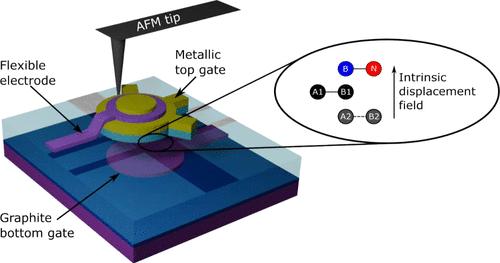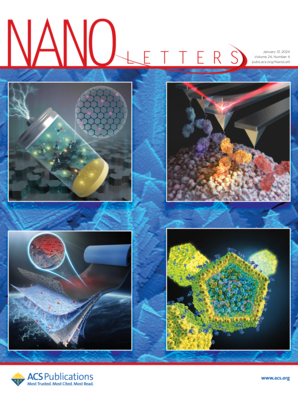Impact of the Angular Alignment on the Crystal Field and Intrinsic Doping of Bilayer Graphene/BN Heterostructures
IF 9.1
1区 材料科学
Q1 CHEMISTRY, MULTIDISCIPLINARY
引用次数: 0
Abstract
The ability to tune the energy gap in bilayer graphene makes it the perfect playground for the study of the effects of internal electric fields, such as the crystalline field, which are developed when other layered materials are deposited on top of it. Here, we introduce a novel device architecture allowing simultaneous control over the applied displacement field and the crystalline alignment between two materials. Our experimental and numerical results confirm that the crystal field and electrostatic doping due to the interface reflect the 120° symmetry of the bilayer graphene/BN heterostructure and are highly affected by the commensurate state. These results provide unique insight into the role of twist angle in the development of internal crystal fields and intrinsic electrostatic doping in heterostructures. Our results highlight the importance of layer alignment, beyond the existence of a moiré superlattice, to understand the intrinsic properties of a heterostructure.

角度排列对双层石墨烯/氮化硼异质结构晶体场和本征掺杂的影响
调节双层石墨烯的能隙的能力使其成为研究内部电场效应的理想场所,例如晶体场,当其他层状材料沉积在其上时,就会形成晶体场。在这里,我们介绍了一种新的器件结构,允许同时控制施加的位移场和两种材料之间的晶体排列。我们的实验和数值结果证实,由于界面引起的晶体场和静电掺杂反映了双层石墨烯/氮化硼异质结构的120°对称性,并受到相称态的高度影响。这些结果对扭角在异质结构内部晶体场的发展和本征静电掺杂中的作用提供了独特的见解。我们的结果强调了层排列的重要性,超越了莫尔维尔超晶格的存在,以理解异质结构的内在性质。
本文章由计算机程序翻译,如有差异,请以英文原文为准。
求助全文
约1分钟内获得全文
求助全文
来源期刊

Nano Letters
工程技术-材料科学:综合
CiteScore
16.80
自引率
2.80%
发文量
1182
审稿时长
1.4 months
期刊介绍:
Nano Letters serves as a dynamic platform for promptly disseminating original results in fundamental, applied, and emerging research across all facets of nanoscience and nanotechnology. A pivotal criterion for inclusion within Nano Letters is the convergence of at least two different areas or disciplines, ensuring a rich interdisciplinary scope. The journal is dedicated to fostering exploration in diverse areas, including:
- Experimental and theoretical findings on physical, chemical, and biological phenomena at the nanoscale
- Synthesis, characterization, and processing of organic, inorganic, polymer, and hybrid nanomaterials through physical, chemical, and biological methodologies
- Modeling and simulation of synthetic, assembly, and interaction processes
- Realization of integrated nanostructures and nano-engineered devices exhibiting advanced performance
- Applications of nanoscale materials in living and environmental systems
Nano Letters is committed to advancing and showcasing groundbreaking research that intersects various domains, fostering innovation and collaboration in the ever-evolving field of nanoscience and nanotechnology.
 求助内容:
求助内容: 应助结果提醒方式:
应助结果提醒方式:


